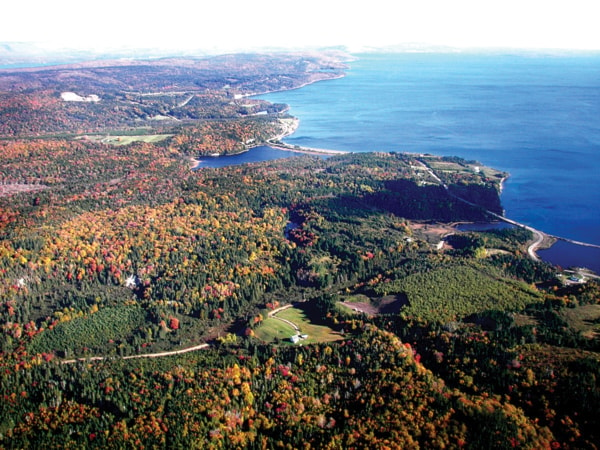SYDNEY, N.S. — Following years of work lobbying government, it’s time to celebrate the natural beauty and diverse ecosystem of the Bras d’Or Lake, an inland saltwater sea in Cape Breton, N.S.
The lake became Canada’s 16th United Nations Educational, Scientific and Cultural Organization biosphere reserve following a meeting of the United Nations man and biosphere international co-ordinating council in Dresden, Germany, in June.
Now, the Bras d’Or Lake Biosphere Reserve Association is planning a weekend of celebrations to mark the designation.
Jim Foulds, vice-chair of the association, leads a committee organizing the festivities planned for Sept. 17-18.
“Having the designation means that over the next 10 years when the designation will be up for renewal ... we’ll have to show what we’ve done to promote those four pillars of sustainability — healthy environment, society, culture, and economy,” he said.
“It’s not only a recognition of what’s happened in the past, but it’s sort of a commitment to the future. So we’re going to keep doing what we’ve been doing, and maybe do even more of it.”
While a biosphere reserve designation doesn’t confer any new powers — decisions still rest with the various levels of government — the main benefit is to gain international recognition of the Bras d’Or Lake as a “special world asset,” according to the association.
It also provides a platform for co-operation on approaches to management, research and education in ecosystem conservation and the sustainable use of natural resources in the lake.
The biosphere reserve includes the Middle River wilderness area, Whycocomagh Provincial Park, Ben Eoin Provincial Park, Bornish Hill nature reserve, Spectacle Island game sanctuary and the Irish Cove ecological monitoring assessment network site.
“This is a group of people who want to move forward and make sure the momentum is kept up in terms of trying to promote sustainable lifestyles, promoting best practices, promoting a healthy environment, society and economy,” Foulds said.
The association’s work took several years to complete, including holding scores of public consultation meetings and the endorsement of Cape Breton Island’s municipalities, the provincial government and the five First Nations communities on the island.
Volunteers put thousands of hours of work into the 300-page application document before it moved on to UNESCO officials in Ottawa and Paris, France.
However, the application failed to convince local politicians in Inverness County to support the biosphere project.
The municipality voted against the biosphere proposal in February 2009. Despite attempts to convince councillors this designation wouldn’t have any adverse effects on property owners or industry, the municipality wouldn’t reconsider.
The deputy warden at the time, Ed MacDonald, said there were too many “unanswered questions” about assigning a biosphere reserve to the Bras d’Or Lake.
Despite failing to gain Inverness County’s blessing, the proposal moved forward, Foulds said.
He said 90 per cent of the people the association interacted with throughout the process thought the biosphere concept was a “fantastic” idea.
“Whatever opposition did crop up from time to time was basically because it was a new idea, it was called a biosphere reserve.
“It was the word ‘reserve’ which was a terrible thing to try to sell to people and tell them there’s nothing going to be changed in terms of your use of the area.”
Among the groups the association received support from were the Bras d’Or Stewardship Society, the Collaborative Environmental Planning Initiative, which is a Bras d’Or Lake project that complemented efforts to declare the lake a biosphere reserve, and the Unama’ki Institute of Natural Resources, based in Eskasoni.
Lisa Young, executive director of the Unama’ki Institute, said with the designation comes responsibilities to maintain the lake’s diverse environment.
“The level we have right now is something we’re going to have to sustain to keep the designation,” she said.
“I know that through a couple of our organizations, such as (Collaborative Environmental Planning Initiative), have been talking with the biosphere reserve association and are now in the process of making plans on how we can better communicate, and work together to ensure that this is something that’s going to continue.”
There is a world network of 550 biosphere reserve sites in 105 countries, of which 16 are located in Canada.
There will be events across the Bras d’Or Lake biosphere reserve this weekend put on by community groups as well as the Bras d’Or Lake Biosphere Reserve Association.
The association will be hosting its marquee event at the Highland Village Museum in Iona on Sept. 17 from 2-5 p.m.
“It’s a celebration, but it’s also an awareness building tool. It’s going to be a chance for people to come out to hear about the biosphere reserve, pick up information about it, learn a bit more about it, and have a good time at the same time,” Foulds said.
A list of the various events being held can be found at www.blbra.ca/a-celebration-weekend.
———
QUICKFACTS
The Bras d’Or Lake derives it name from Cape Breton’s first European French explorers and settlers who called it “Arms of Gold.” Some say it actually is a corruption of the name for Labrador.
The Mi’kmaq First Nation named it Pitu’pok meaning “Salt Water.” Cape Breton was called Unama’kik, or “Land of Fog.”
The saltiness of this inland sea is 60-70 per cent the salinity of the Atlantic Ocean, being a mixture of the five main rivers that flow into it and the two connections with the ocean — the Great Bras d’Or and the Little Bras d’Or channels.
There is a man-made connection to the ocean in the form of a canal at St. Peter’s, N.S.
The surface area of the lake is 1,098 square kilometres. It is about 71 km long and 32 km wide.
